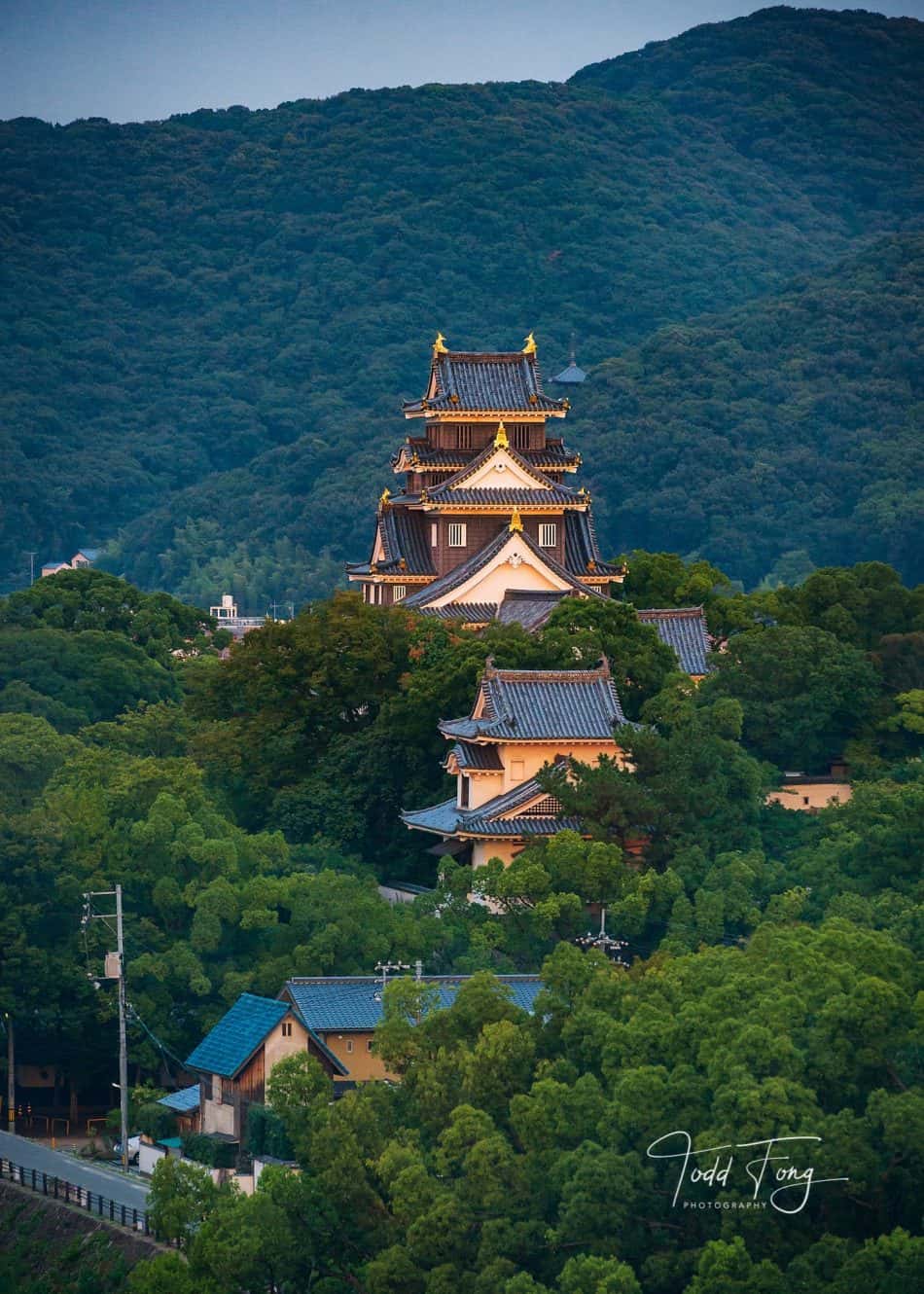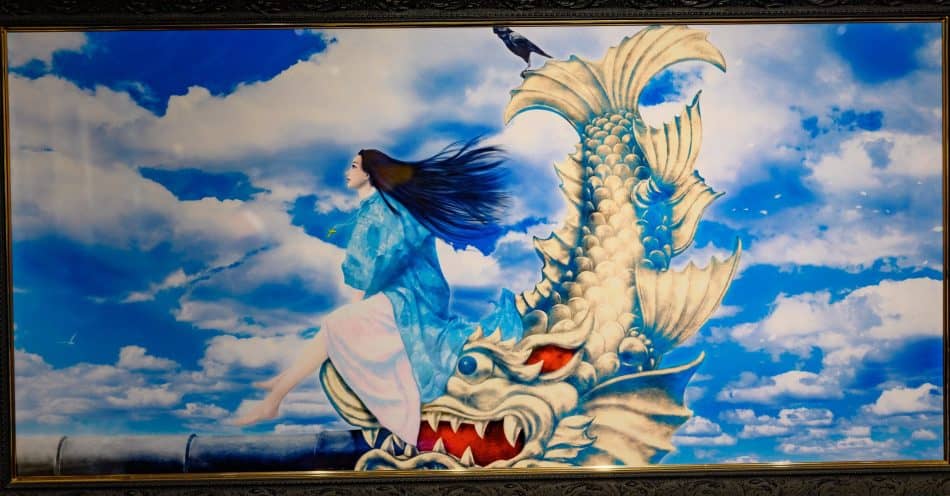
The latest remake of the series Shogun based on the James Clavell novel has spurred a new interest in Japan’s samurai history, particularly the complicated intertwining of Christianity with the politics of the day. Although Shogun portrays the Jesuits in an exaggerated, cynical fashion (keep in mind it is a work of fiction, not history), it is a fact that many of the samurai daimyo lords of that era identified as Christians. It isn’t my place to judge the motivations of each individual samurai’s decision to convert to Christianity, but the story of one particular samurai lord and his family caught my attention.
On a writing assignment in 2019, I visited Okamoto Castle, “The Shining Crow”, known for its black exterior complemented by a set of gold-leafed koi ornaments along the roof, reflecting the rays of the setting sun. In a display by artist Kimiya Masago depicting the life of the first lord of the castle, Ukita Hideie, there was a curiosity. An illustration of his wife, Minami no Onkata, nee Maeda Gou, in which she sat astride one of the great koi on the roof. Around her neck, prominently represented in the image was a gold crucifix.
 Illustration of Maeda Gou (Minami no Onkata) by Kimiya Masago
Illustration of Maeda Gou (Minami no Onkata) by Kimiya Masago
The Christian Faith of Gohime
Traveling around Japan, I have taken an interest in the existence of early Christians in Japan, particularly among the ruling class. While there is solid evidence of many Christian daimyos existing prior to the first edict against Christianity made by Toyotomi Hideyoshi in 1587, much of the history after that time has been erased, hidden, or even rewritten to suit the victors.
What made this case more interesting, however, was that Minami no Onkata, whom I will now address as Gohime (Princess Go) was a beloved adopted daughter of none other than Toyotomi himself. If Gohime was a Christian, did she become one in defiance of her father’s edict, or did her father invoke the edict in spite of the fact that his own daughter was a Christian? In this instance, the evidence didn’t require much searching to uncover.
Gohime, as it turns out, converted to Christianity nearly 20 years after her father’s edict, around 1606. By then, her husband Hideie and their two sons had been exiled to a distant island, punishment for Hideie’s loyalty to Toyotomi against Tokugawa Ieyasu, who defeated Toyotomi to become the Shogun of Japan. Gohime returned to the home of her adopted family in Kyoto. Toyotomi had already passed in 1598, but her adopted mother Kitanomandokoro, a woman of considerable influence and power still remained at the family home with her multitude of servants. Where the story becomes even more interesting is when we examine the household of Kitanomandokoro, the first wife of Toyotomi.
Kitanomandokoro: Defender of Early Christians
Many texts record Kitanomandokoro becoming a dedicated Buddhist nun after she was widowed. However, during her reign as basically the First Lady of the Momoyama Period (1573–1600), she wielded great influence both with her husband and on her own, a rarity for a woman in those days. Toyotomi and Kitanomandokoro adopted several children from prominent families, including Gohime and her older sister Mahime. Although, at that time, “adoption” could be a euphemism for holding a child hostage to maintain good relationships with their family, records show that Toyotomi and Kitanomandokoro cared deeply for each of them.
Kitanomandokoro initially strongly opposed the Jesuits and the spread of Christianity, and was described in Jesuit letters as being “cold and unkind”. However, many members of her household had become interested in Christianity, and more than a few converted, a situation which despite her original feelings, she at least tolerated. Over time, her regard for Christianity changed until she had completely reversed her opinion about Christians and the Jesuits. It has been strongly suggested that when the Jesuit priests and Christian daimyos could not get Toyotomi to relax his edict against Christianity, Kitamandokoro successfully petitioned her husband for leniency toward the Jesuits and their disciples.
Later in life, Kitanomandokoro was recorded as saying “…it seems to me that Christianity has great rationale. And it is superior to any other religion, and it is more plausible than many existing Japanese religions.” She continued: “Every Christian agrees on one truth, and claims that to be true. That makes me believe that [Christianity tells] the truth. Japanese religions never agree, and are never the same.” Although it was never recorded that Kitanomandokoro ever officially converted to Christianity, her words suggest an understanding of the gospel message deeper than most Japanese had at the time.
Women of Faith in Early Japanese Christianity
Because of Kitanomandokoro’s support of Christians and tolerance for Christians in her own household, Gohime was able to grow up under the influence of several women who were well educated in the gospel and regular attendees of the large Christian church in Osaka. Her husband Ukita Hideie was not a recorded Christian, but his Okayama domain officially gave Christians permission to reside and evangelize. His mother, Fuku, like Kitanomandokoro, was a vocal defender of Christians and she often received appeals from the Jesuits for help. Thus, after her marriage, Gohime continued to live in an environment supportive of Christianity and probably contained Christian servants.
So perhaps it was only natural that later, faced with the trials of being separated from her husband and sons forever, Gohime finally grasped the full understanding of God’s love and mercy. Her sons had been baptized before their exile; she could now be reunited with the family she was forcefully separated from in this life. After her conversion, she returned to her birth home in Kanazawa where she made a substantial donation for the building the church there. Christianity in nearby Kanazawa had thrived under the protection of the Maeda clan, which Gohime was a member of. Gohime remained at the estate of her birth family until her death at the age of 61.
References:
The Conversion of Hideyoshi’s Daughter Gō, by Tomoko Kitagawa, Japanese Journal of Religions Studies 34/1: 9–25 © 2007 Nanzan Institute for Religion and Culture
Kitanomandokoro: a lady samurai behind the shadow of Toyotomi Hideyoshi, by Tomoko Kitagawa, UBC Theses and Dissertations
